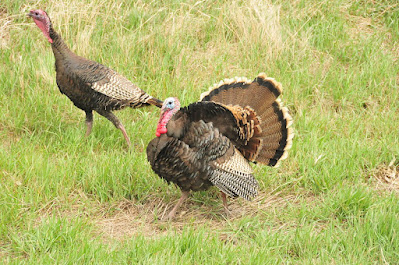The NJDEP Fish & Wildlife's Turkey Project's Wild Turkey Brood Sighting Survey is in its final month. It began June 15th and ends September 15, 2024. This survey information is used as a measure of wild turkey productivity both in New Jersey and nationally as a means of estimating how well turkeys raise broods each year. Have you seen turkey hens and their young poults? Then let NJDEP know by filling in the online survey. (more info below)
Turkeys get most of their attention in November as Thanksgiving approaches, but wild turkeys (Meleagris gallopavo) are not what most Americans will serve on that holiday.
This bird native to North America, is the largest of the Galliformes group of game birds which includes grouse, pheasants, and partridges. It is the same species as the domestic turkey stocked in grocery stores which was originally derived from a southern Mexican subspecies of wild turkey.
Wild turkeys do not migrate and I see them in the small woods near my suburban NJ neighborhood.
They are active during the day when they have very good eyesight, but their vision is very poor at night. To avoid predators at night they will roost in trees well off the ground.
I will see wild turkeys foraging on the ground or even visiting backyard bird feeders, and hear their vocalization described as"gobbles", "clucks", "putts", "purrs", "yelps", "cutts", "whines", "cackles", and "kee-kees."
In early spring, males older than 1 year old (sometimes called gobblers or toms) and males younger than 1 year old (sometimes called jakes) gobble to announce their presence to females and competing males.
If you are completing the brood survey based on a sighting, it is good to note that since hens may lose their young or may not nest at all, it is important to record lone hens as well as those with poults. To the best of your ability, each of your record entries should be of new broods when this is known. Please do not submit the same brood you see every day as a separate survey entry. Example: If the same brood visits your backyard every day, this would be one entry for the entire period of the study. If you cannot tell poults from hens, especially in this later month of the survey, please record them in the "unknown" section of this survey. Each time data is submitted, via the submit button at the bottom of the screen, it is counted as a single record.


No comments:
Post a Comment